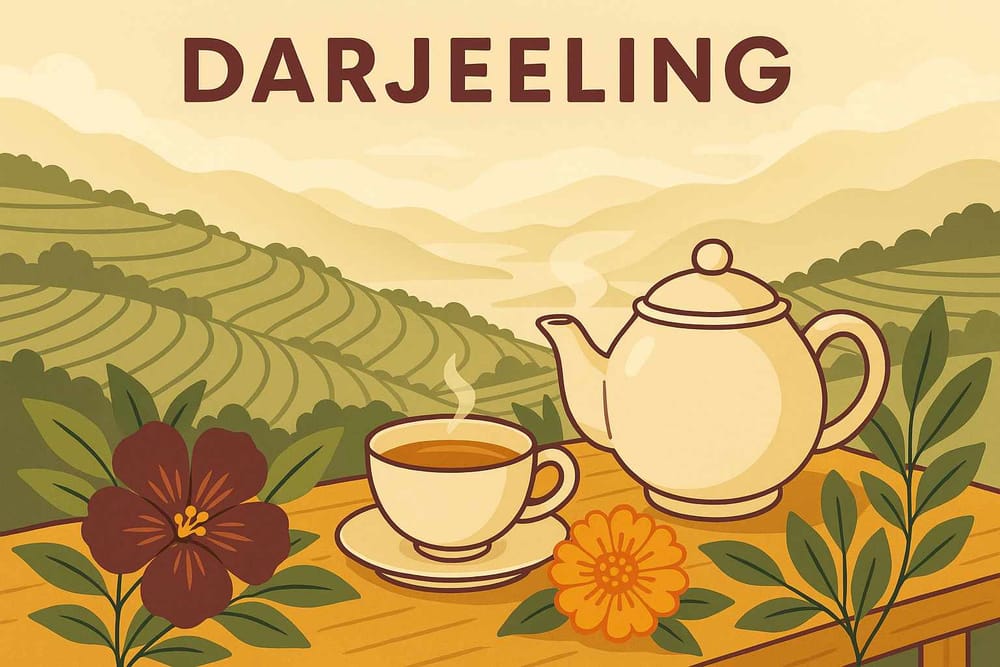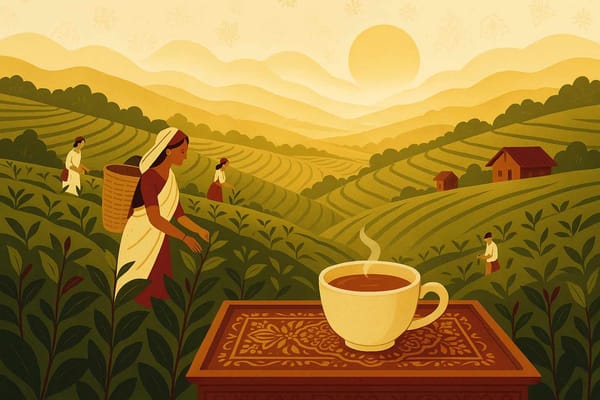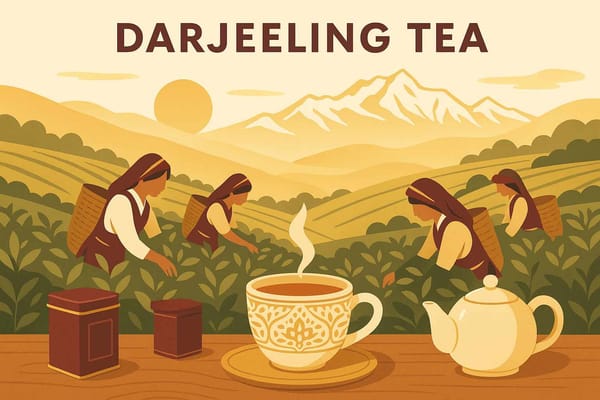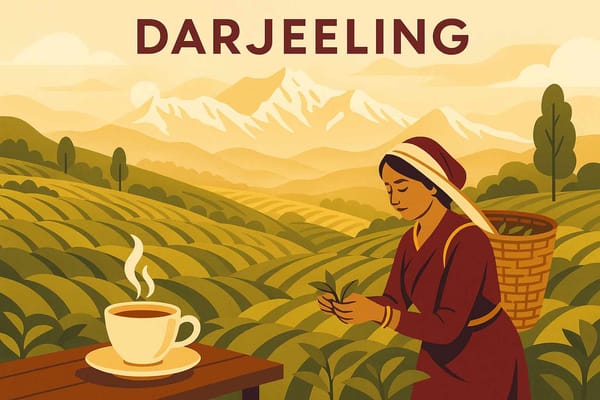
Darjeeling Tea Secrets: History-Varieties-Brewing Explored
There's a certain magic that hangs in the misty air of the Darjeeling hills. It’s a feeling of peace, of being close to nature, and of touching a history that is as rich and layered as the soil itself. This very magic is captured in a cup of Darjeeling tea. For many of us, it’s not just a beverage; it’s an experience, a morning ritual, a moment of quiet reflection. It’s the warmth that seeps into our hands and the delicate aroma that transports us straight to those beautiful, rolling tea gardens.
Often lovingly called the "Champagne of Teas," this Himalayan elixir is more than just a world-famous brew. It’s a symbol of our Indian heritage, a testament to human dedication, and a story of how a tiny leaf from the mountains found its way into the hearts of people across the globe. So, let’s take a journey together and explore the fascinating world of this treasured drink.
A Journey Through Time: The History of Darjeeling's Golden Brew
The story of Darjeeling tea begins not with an ancient Indian tradition, but in the mid-19th century, during the British era. The British, in their quest to find an alternative to Chinese tea, saw immense potential in the Indian subcontinent. In 1841, a civil surgeon named Dr. Archibald Campbell planted the first seeds of the Camellia sinensis plant in his garden in Darjeeling. He probably didn't know then that he was planting the seeds of a global legacy.
The Himalayan foothills, with their high altitude, cool winters, cloud cover, and sloped terrain for drainage, turned out to be the perfect home for these tea bushes. The unique combination of these natural factors, what experts call 'terroir', is what gives Darjeeling tea its incredibly special and delicate flavour—a flavour that simply cannot be replicated anywhere else in the world. By 1866, the region was dotted with 39 flourishing tea gardens, a number that grew to 56 just a few years later. To protect this unique identity, Darjeeling tea was given the Geographical Indication (GI) tag in 2004, ensuring that only tea grown in these specific gardens can carry this prestigious name. This protection of authenticity is a beautiful reflection of how India safeguards its heritage, much like the efforts to preserve the timeless arts and crafts of Mewar's rich heritage.
The Many Moods of Darjeeling: Understanding the Varieties
Just like the seasons change the landscape of the hills, they also change the character of the tea. The flavour, colour, and aroma of Darjeeling tea depend heavily on when the leaves are harvested. This is what makes exploring its varieties such a delightful experience.
- First Flush (Spring Harvest): Harvested from mid-March after the winter slumber, the first flush is the most prized and delicate of all. The liquor is light golden, and the flavour is fresh, floral, and slightly astringent, with a lively character that awakens the senses. It’s a truly special brew that captures the essence of a Himalayan spring.
- Second Flush (Summer Harvest): Plucked in June, the second flush leaves have soaked up the summer sun, resulting in a fuller body and a beautiful amber colour. This is the flush famous for its unique 'muscatel' flavour—a delightful mix of fruity and musky notes that is the signature of a classic Darjeeling tea.
- Autumnal Flush (Post-Monsoon Harvest): After the monsoon rains, the final harvest of the year takes place. The autumnal flush offers a darker, copper-coloured liquor with a bolder, creamier body. The flavour is smooth and mellow, with hints of nuts and spices, making it a perfect, comforting cup for cooler evenings.
Beyond these flushes, Darjeeling tea is also available as Oolong (a semi-fermented tea with a lovely orange hue), Green Tea (unfermented and packed with antioxidants), and White Tea (the least processed, made from the youngest buds).
The Art of Brewing: How to Savour Every Sip
To truly appreciate the delicate and complex flavours of Darjeeling tea, brewing it the right way is key. It’s a simple art that can transform your tea experience from good to absolutely sublime. A common question people have is why this tea is best enjoyed without milk. The answer is simple: its flavours are so subtle and nuanced that milk can easily overpower them. To enjoy its true character, it’s best had on its own.
Here’s how you can brew a perfect cup:
- Use Fresh Water: Always start with fresh, filtered water. Don’t re-boil water, as it loses oxygen, which affects the taste.
- Watch the Temperature: Bring the water to a boil and then let it cool for a minute or two. The ideal temperature is between 80-96°C (175-205°F). Water that's too hot can burn the delicate leaves.
- Measure with Care: Use about one teaspoon (2-3 grams) of loose-leaf tea for every cup (240 ml) of water.
- Steep, Don't Stew: Let the leaves steep for 3-5 minutes. You can adjust this based on how strong you like your tea. Over-steeping can make it bitter. Some high-quality first flush teas can even be steeped a second time!
And what about storing this precious tea? To keep its freshness intact, store your Darjeeling tea in an airtight container, away from direct sunlight, moisture, and strong smells like spices or coffee. This will help preserve its beautiful aroma and flavour for a long time.
More Than Just a Drink: A Cultural Elixir
A cup of Darjeeling tea is a moment of mindfulness. It contains caffeine, but usually less than coffee, offering a gentle lift rather than a jolt. The act of brewing it, waiting for it to steep, and finally taking that first sip is a ritual that calms the soul. Its subtle flavours remind us of the beauty found in simplicity, much like how traditional Ayurvedic spices do more than just add taste—they bring balance and wellness to our lives.
At Bhaktilipi, we believe in cherishing these traditions that connect us to our roots. Our culture is filled with such simple yet profound practices that bring peace and meaning to our daily lives. Exploring the story of Darjeeling tea is just one way to connect with the rich tapestry of our Indian heritage.
If you love diving deep into the stories behind our timeless traditions, we invite you to explore more with us. Stay connected by subscribing to our YouTube channel for insightful videos, following us on Instagram for daily inspiration, and joining our wonderful community on Facebook. Let’s continue this journey of discovery together.
Embracing the Essence of Darjeeling Tea
From its humble beginnings in the Himalayan foothills to its revered status across the world, Darjeeling tea carries a charm that is truly timeless. Every sip is a story of the misty mountains, the skilled hands that plucked the leaves, and the rich legacy of our land.
So, the next time you brew a cup, take a moment. Inhale its floral aroma, notice the beautiful colour of the liquor, and appreciate the journey it took to reach you. Let it be a gentle reminder to pause, reflect, and cherish the small, beautiful details that make life so special.
A passionate group of people dedicated to preserving India's knowledge of Dharma, Karma, and Bhakti for ourselves and the world 🙏.
Comments
Related in

Exploring the Rich History and Unique Flavors of Darjeeling Tea: A 2025 Guide
Imagine this: a gentle mist rolling down the majestic Himalayas, the air crisp and clean, and in your hands, a warm cup of tea. With the very first sip, you’re not just tasting a beverage; you're experiencing a story—a legacy that has travelled through time from

Exploring the Rich History and Unique Flavors of Darjeeling Tea- A 2025 Guide
Have you ever held a cup of warm tea that feels like it holds the secrets of the mountains? A brew that smells of mist, sunshine, and wild blossoms all at once? For me, and for millions of Indians, that experience is perfectly captured in a cup of Darjeeling tea.

Exploring the Rich Legacy of Darjeeling Tea: History and Culture Defined
Have you ever held a cup of tea that felt like holding a story? A warmth that seeps into your hands and a fragrance that transports you to misty mountains. For me, that's what a cup of Darjeeling tea does. It’s more than just a morning beverage;
